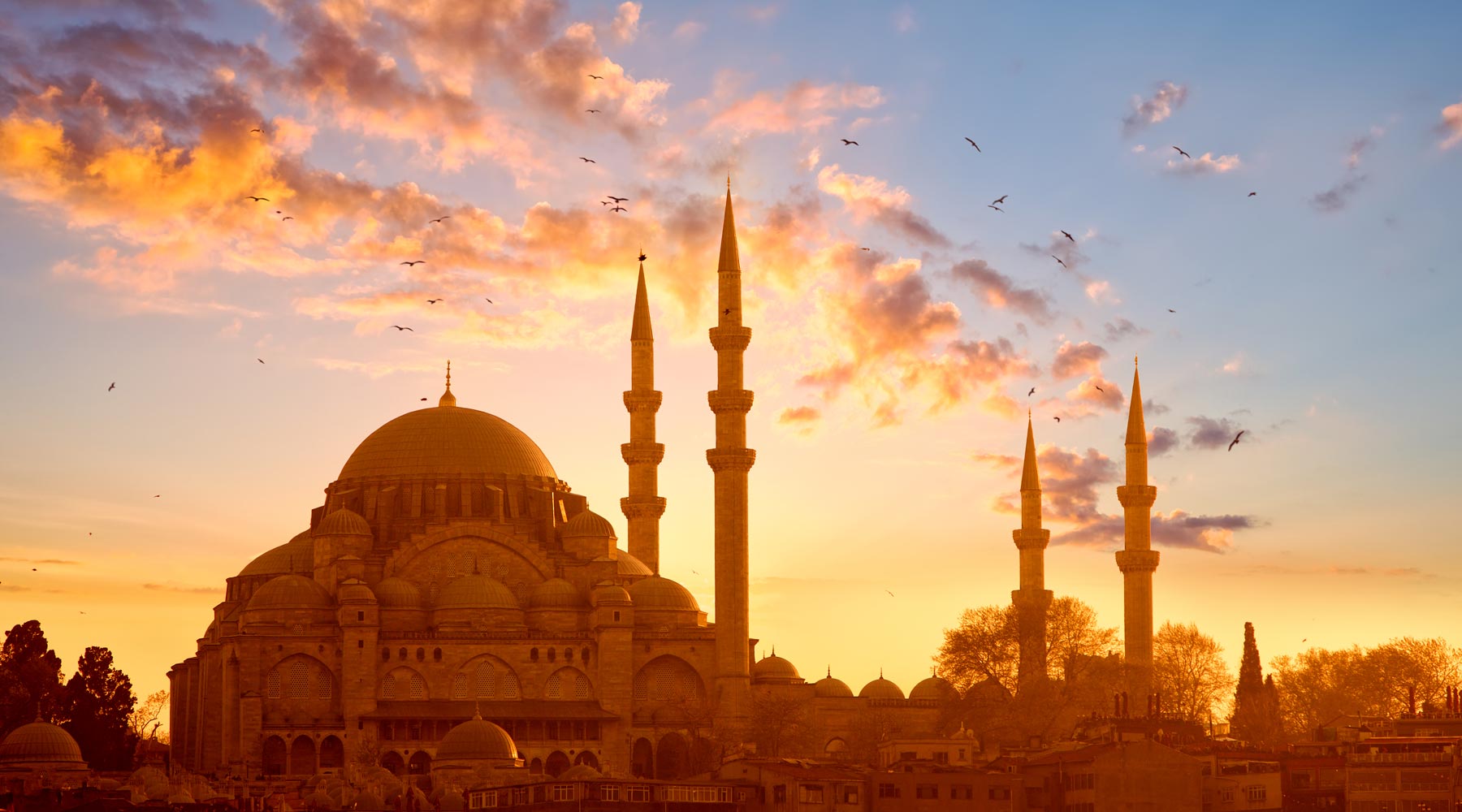Istanbul in Turkey draws a considerable number of homegrown and foreign tourists every year with its rich social legacy. This peninsula has an ancient history with remarkable buildings, museums, and other structures. One of the religious structures is Süleymaniye Mosque, attracting many people to the Turkish culture. How about getting a close glance at the Süleymaniye Mosque, especially its compositional characteristic?
History and Impressive Events
The establishment of the Süleymaniye Mosque began in 1550 and finished in 1557. Committed to Prince Mehmed, the mosque was finished with the inclusion of all state organs. It was charged by Suleiman the Magnificent. The public considered it the “mosque that will always remain” to demonstrate its powerful construction. It is the ideal delineation of Sinan’s resourcefulness as a planner. The mosque is one of the most important places for people who want to learn more and more about architecture. Nowadays, Suleymaniye Mosque is utilized as a social complex.
Although the mosque is recognized as the showpiece of Sinan the Architect, the headman himself called it “a work as a simple building.” He altogether thought about everything to the best detail when arranging the mosque. The four minarets of the Süleymaniye Mosque address the four rulers who took the seat after the triumph of Constantinople. At the same time, the ten balconies on the minarets allude to Suleiman’s being the tenth Ottoman king.
Materials and experts were brought from each edge of the realm. Ships and trucks conveyed a consistent stream of stone, marble, block, sand, and lumber supplies. Stones were generally brought from Davutpaşa. Two of the goliath stone sections were brought from Istanbul, and the other two from Baalbek. Marble from the remnants of old structures in Salonica and Gaza were likewise utilized. The clasp of inner iron clips that joined the stones of the mosque was brought from Samokov, and the lead used to cover the vaults was secured from mines in Serbia. Ceramic tiles were made in Iznik and Istanbul.
In 1660, There was a massive fire that harmed the mosque. Sultan Mehmed IV decided to reestablish there again and perfectly has done it. A piece of the arch fell during the seismic waves of 1766. The resulting fixes harmed what was left of the first adornment of Sinan (ongoing cleaning has demonstrated that Sinan tested first with blue before making red the prevailing shade of the arch). During World War I, the yard was utilized as a weapon station, and when a portion of the ammo was lighted, the mosque endured another discharge. Not until 1956 was it completely reestablished.
How to Get to Süleymaniye Mosque
The Süleymaniye is in the city’s Third Hill, only north of Istanbul University, overlooking the Golden Horn. This mosque is situated in the region of Fatih; the Süleymaniye Mosque has incredible strict importance. Likewise, it is perhaps the main design from the Ottoman period. The mosque is near the Spice Bazaar and the Grand Bazaar. To get the full impact of the designer’s plan and Süleymaniye’s glory, you should stroll toward the northwest side of the mosque on Şifahane Sokak and enter the yard through this entrance and the terrific patio. It’s a simple stroll of fewer than 10 minutes around the college from Beyazıt Square and the Grand Bazaar to the Süleymaniye. The Süleymaniye takes off wonderfully towards the sky with nothing to prevent its rising.
The working Süleymaniye Hamamı is on the eastern side of the mosque. To one side (southeast) of the mosque’s primary passageway is the burial ground, home to the octagonal burial chambers of Süleyman and his significant other Haseki Hürrem Sultan (Roxelana). The tile work encompassing the passageways to both is magnificent, and the ivory-trimmed boards in Süleyman’s burial place are stunning.
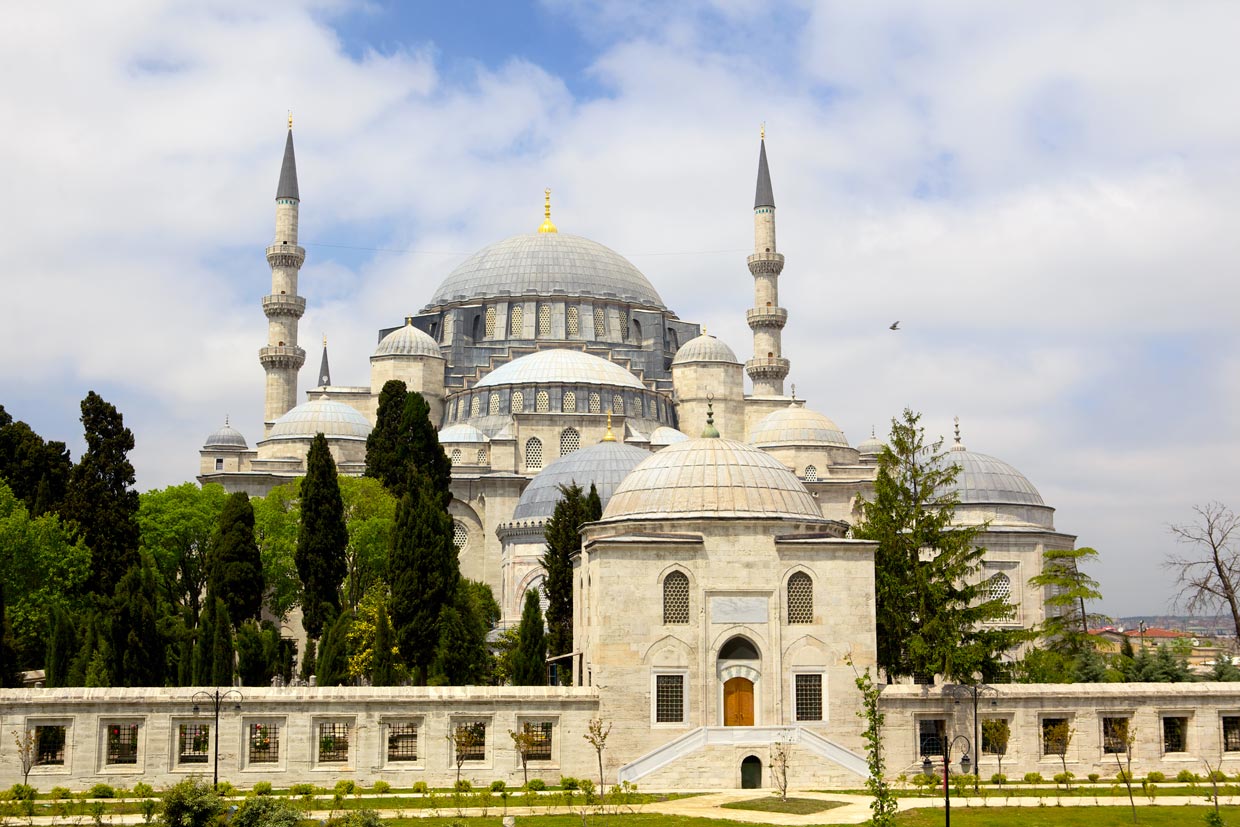
Architecture
Following three years of broad rebuilding efforts by engineers and calligraphers under the vigilant gaze of building antiquarians and costs of 21 million turkey lira, the mosque was re-opened to guests during Kurban Bayramı in 2010. From the inside view, the structure is fantastic and makes you surprised. Sinan joined the four supports into the dividers of the structure – the outcome is superbly ‘transparent’ (like open and breezy) and reminds of Aya Sofya mosque, especially the arch is as extensive as the one that crowns the Byzantine basilica.
Today Süleymaniye mosque is one of the most mainstream sights in Istanbul. Regularly travelers enter the mosque from the inward yard and after taking the shoes off. Camera and flash are permitted in the mosque. This mosque is one of the great symbols of Islamic art all around Turkey. Beautiful tiles with colorful shapes, extraordinary architecture, spiritual spaces, and historical stories all get around together in an ancient place, making this mosque one of the important mosques in the world. Try not to miss this irreplaceable asset during your visit to Istanbul.
Exterior
Like the other supreme mosques in Istanbul, the passage to the actual mosque is gone before by a forecourt with a focal wellspring. The yard is of extraordinary loftiness with a colonnaded peristyle with marble, stone, and porphyry segments. The northwest exterior of the mosque is improved with rectangular Iznik tile window lunettes. The mosque is the main structure where the Iznik tiles are used. At the four corners of the yard are the four minarets. The two taller minarets have three exhibitions (Serifes) and ascend to a height of 63.8 m (209 ft) without their lead covers and 76 m (249 ft) including the covers. Four minarets were utilized for mosques presented by a ruler (rulers and princesses could build two minarets; others just one). The minarets have an aggregate of 10 displays, which by custom shows that Suleiman I was the tenth Ottoman king.
The fundamental vault is 53 meters (174 feet) high and has a distance across of 26.5 meters (86.9 feet) which is actually a large portion of the height. At the time it was constructed, the arch was the most elevated in the Ottoman Empire when estimated from ocean level, yet at the same time lower from its base and more modest in measurement than that of Hagia Sophia.
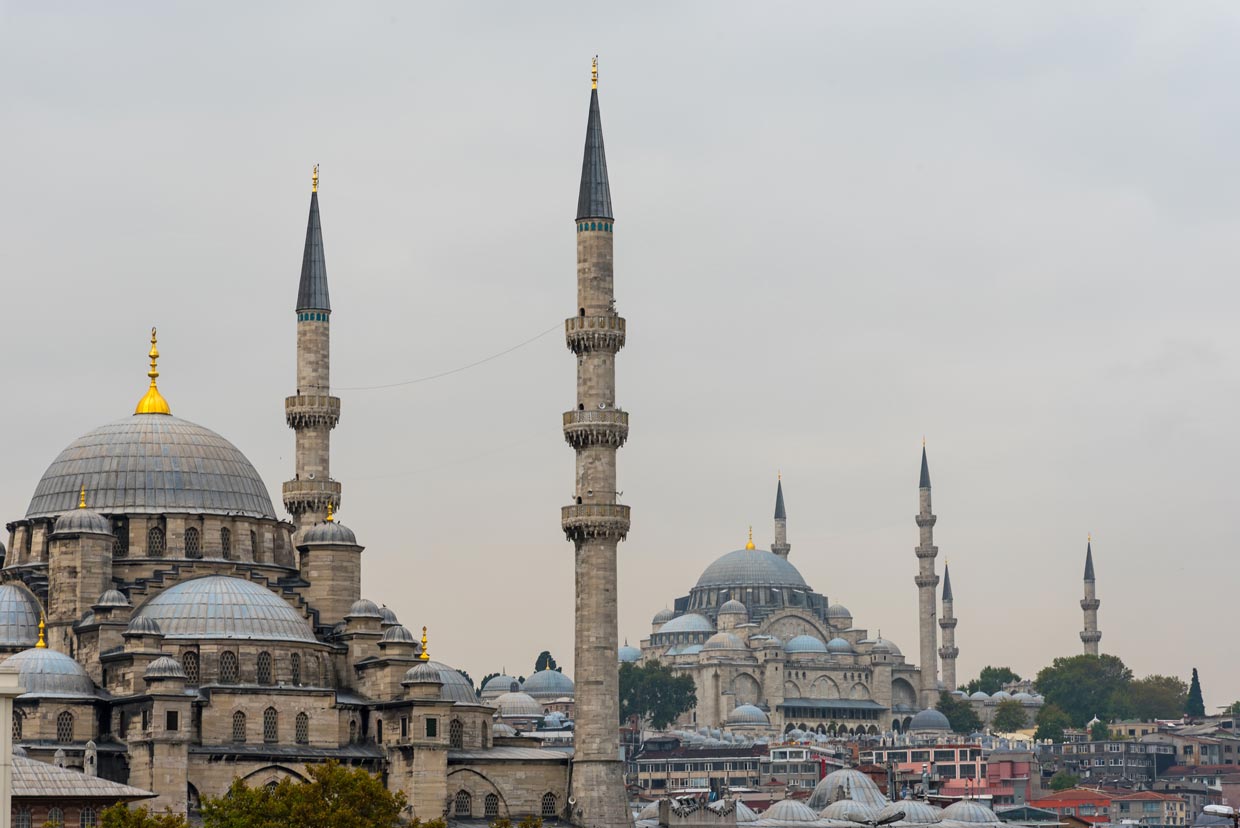
Interior
The inside of the mosque is practically square, 59 meters (194 feet) long and 58 meters (190 feet) in width, shaping an immense solitary space. The vault is flanked by semi-arches and toward the north and south curves with tympana windows, upheld by gigantic porphyry stone monuments. Sinan chose to make a revolutionary building development to cover the immense north-south buttresses expected to help focal walls. He consolidated the braces into the dividers of the structure and afterward concealed the projections by building colonnaded galleries. There is an exhibition inside the mosque and a two-story gallery outside.
Inside, the mosque is limited with stained-glass windows facing the qibla wall. Iznik tile revetments are just utilized around the Mihrab. The rehashing rectangular tiles have a stencil-like flower design on a white background. Besides, there are different shapes of flowers with various colors such as red, green, or blue. On one or the other side of the Mihrab is huge Iznik tile calligraphic roundels with text from the Quran. Other parts have a simple design with woodworks, mostly colored with white paint. Generally, the interior design of the Süleymaniye Mosque is a complete masterpiece in a high level of Islamic Art.
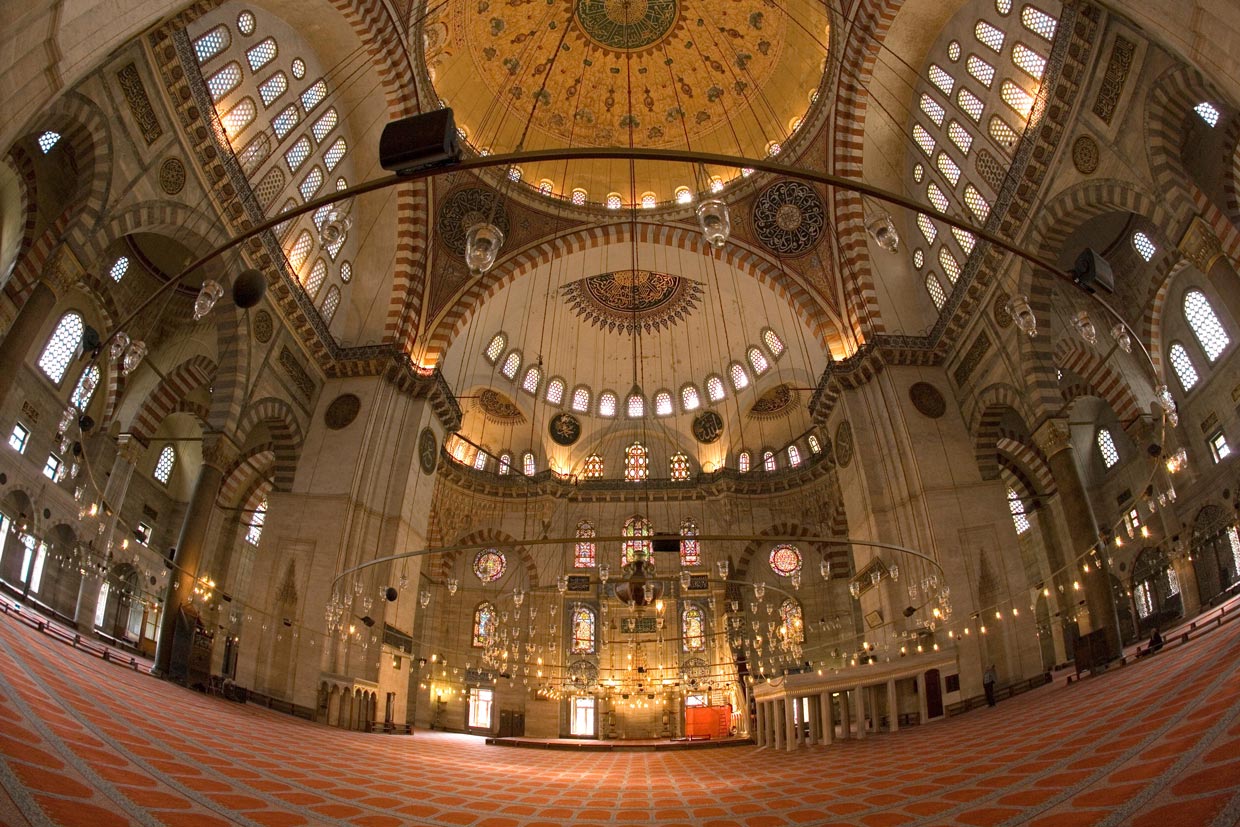
Mausoleums
In the walled nook behind the qibla wall of Sulaymaniyah are the different tombs of Sultan Suleiman I and his wife(Hurrem Sultan). In 1558, she died, and an octagonal sepulcher was built as her monument. The seven rectangular windows are overcome by tiled lunettes and epigraphic boards.
The roof is presently whitewashed however was presumably once painted in white. A bigger monument for Sultan Suleiman was started to be built in 1566 as he died. However, it was most likely not finished until the next year. The tomb is encircled by a peristyle with a rooftop upheld by 24 segments and has the passage pointing toward the east as opposed to the standard north.
Under the colonnade on one or the other side of the passage are Iznik tiled boards. These are the most punctual tiles that are enriched with the light green shading that would turn into a typical element of Iznik tiles. The inside has a bogus vault upheld by eight segments inside the external shell. There are 14 windows set at ground level and an extra twenty for windows with stained glass set in the tympana under the curves.
Around the room over the windows is a band of inscriptive tiled boards. The content statements the Throne section and the accompanying two stanzas from the Quran (2:255-58). Besides the burial chamber of Suleiman the Magnificent, the sepulcher houses the burial chambers of his girl Mihrimah Sultan and those of two later rulers: Suleiman II (administered 1687–1691) and Ahmed II (managed 1691–1695).
Complex
Magnificent mosques in Istanbul are complex which means they have both religious and cultural requirements. No need to mention the Suleymaniye mosque is one of them. It has different parts like, a clinic, elementary school, public showers, four Qur’an schools, a specific school for the learning of hadith, a clinical school, and a public kitchen that serves food to poor people. A large number of these constructions are as yet in presence, and the previous imaret is presently a prominent café. The previous emergency clinic is presently a printing manufacturing plant claimed by the Turkish Army. Out of the mosque dividers, toward the north, is the burial chamber of designer Sinan. It was totally reestablished in 1922.
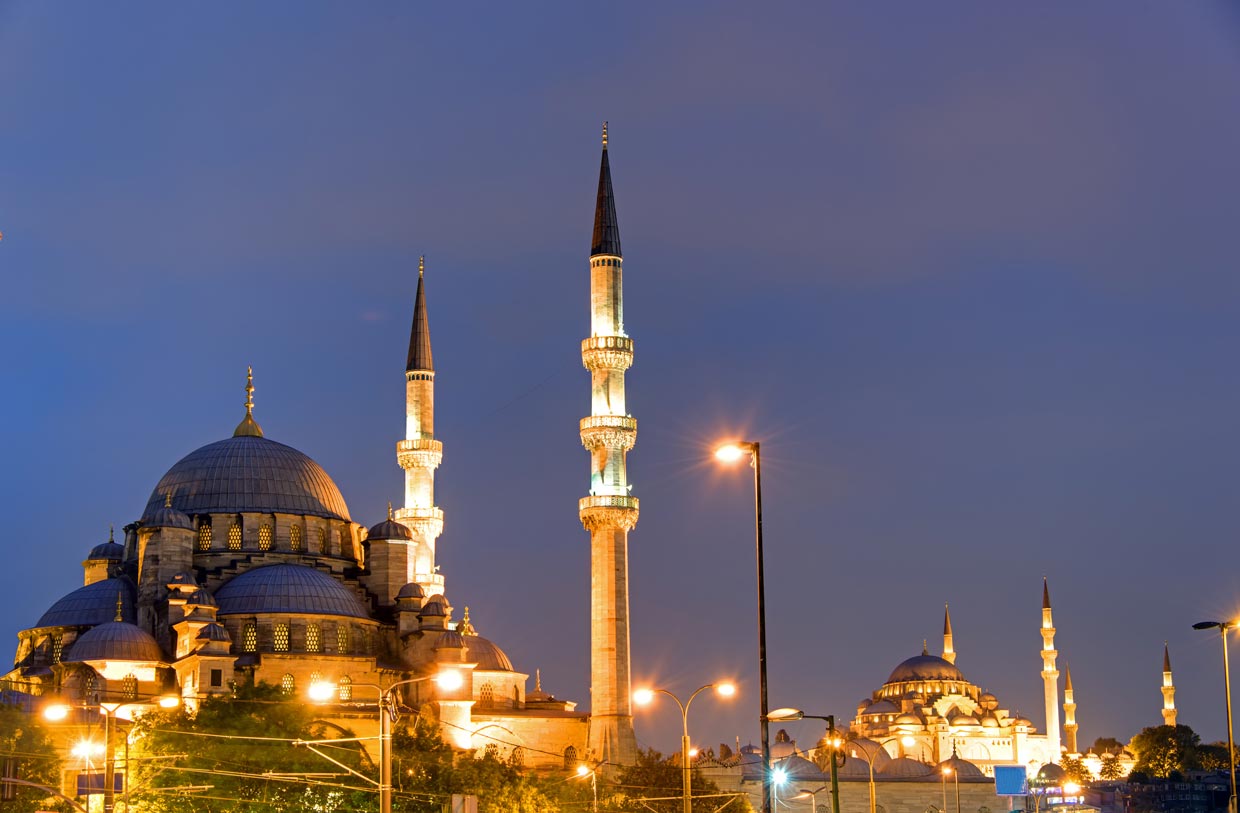
Opening Hours
The mosque is open every day between 9 am and 6 pm but closed during prayer times. If you are not Muslim, try not to visit inside 30 minutes after the call to prayer and from early afternoon to late evening on Friday (the Muslim important religious day). There is no ticket, although donations are welcomed.

About Ottomans Buildings
Generally, two points are especially noteworthy in the antiquated landmarks of the Ottomans: the design of the site and the ideal solidarity of the entirety. Regardless of whether it is in a raised spot, the site consistently has a perspective on huge open spaces. The design overall is wide and forcing.
Fast Facts
- The burial places in the main enclosure of the Süleymaniye Mosque have a place with dignitaries or eminent individuals of note in the Ottoman culture, for example, Asiye and Rabia Sultan, Suleiman the Magnificent, and Sinan the Architect.
- A sediment room was intended to keep harm to the mosque from the candles and oil lights. The residue was gathered in this space to be subsequently utilized as ink.
- The mosque additionally hangs out regarding the brilliant proportion. It’s not hard to find an arc that has a brilliant proportion. The brilliant proportion yields an estimation of 1.618. A similar proportion you get with the Süleymaniye Mosque.
- All Ottoman mosques bore the image of the universe. The bow and the star on the minaret or the vault imply the widespread culture of the Turks.

